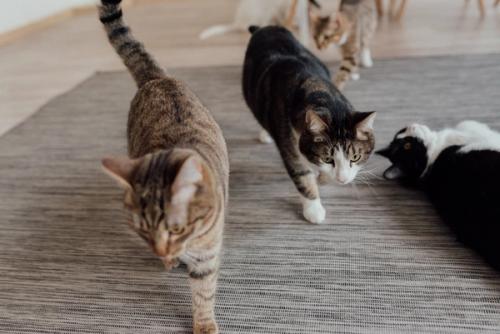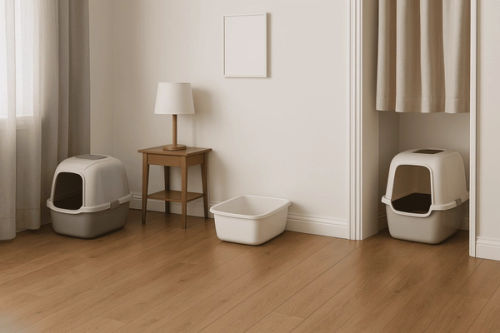
The Complete Guide to Living With Multiple Cats
Published: 4/13/2025
Living with multiple cats can be one of the most rewarding experiences for a cat lover. Watching your feline companions groom each other, nap in sunbeams side-by-side, or team up for zoomies through the hallway is pure magic. But let’s be honest—keeping the peace in a multi-cat household isn’t always a walk in the park. From food fights to litter box standoffs, the dynamics can quickly turn from harmonious to chaotic if the right systems aren’t in place.
In this guide, you’ll learn how to create a balanced environment where each cat feels safe, respected, and happy. We’ll cover everything from how to set up feeding stations and manage litter boxes to handling tension and encouraging positive interactions. Whether you’re welcoming your second cat or managing a whole feline family, this post will help you build a home that works for all paws involved.
Because in the end, a peaceful cat household isn’t just better for them—it’s better for you, too. When your cats thrive together, your home becomes a more joyful, stress-free space for everyone.

Space is Safety: Creating the Right Environment
Cats are deeply territorial animals, and in a multi-cat household, respecting those invisible boundaries is key. Without enough space to claim and retreat to, cats can become anxious, aggressive, or withdrawn.
Vertical vs. Horizontal Space
While square footage matters, so does height. Vertical territory is just as valuable—if not more—for cats. Installing cat trees, wall shelves, or window hammocks allows your cats to spread out and explore their environment without stepping on each other’s paws. These vertical “territories” help reduce competition and give each cat their own domain.
Snuggle Zones and Hideouts
Every cat should have quiet, cozy places where they can rest undisturbed. Think plush beds tucked into corners, cardboard boxes turned into dens, or even a blanket-covered chair. These hideouts provide a sense of control and safety, which is essential in preventing stress and tension in shared spaces.
By offering a variety of perches, hideouts, and rest areas across your home, you give your cats the ability to coexist peacefully—on their own terms.
Meal Time Peace: Setting Up Feeding Stations
Cats may enjoy each other’s company in daily life, but when it comes to eating, they prefer solitude. Most cats are instinctively solitary eaters, and sharing food space can lead to stress, conflict, or resource guarding.
Separate Bowls, Separate Spaces
To minimize competition, each cat should have their own food and water bowls. Position them in separate areas of the home, ideally where the cats cannot see each other while eating. This allows each feline to eat at their own pace and feel secure.
Placement Tips
- Avoid high-traffic areas to create a calm eating environment.
- Never place food bowls next to litter boxes—cats dislike eating near waste.
- Keep water bowls away from food bowls, as many cats instinctively prefer drinking in a separate area.
- A pet water fountain can be a good shared option, encouraging hydration with flowing water.
The Litter Box Formula: Clean, Plentiful, Private
One of the most common sources of tension in a multi-cat home is poor litter box management. A single box isn’t enough and can lead to inappropriate elimination or territorial disputes.
The “One Plus One” Rule
The general guideline is one litter box per cat, plus one extra. For example, three cats should have at least four litter boxes. This ensures access, choice, and privacy for each cat.

Strategic Placement
Litter boxes should be placed in multiple locations throughout the home—not grouped in one room. Consider your cat’s need for quiet and privacy, avoiding noisy appliances or busy hallways. If you live in a multi-level home, provide at least one litter box on each floor.
Daily Cleaning Routine
Consistency is key. Scoop each box at least once a day to maintain cleanliness and reduce odors. Replace litter weekly and wash the boxes with mild soap and water to prevent buildup. A clean box encourages use and helps maintain harmony.
Resource Rich: Duplicating Essentials
Cats are territorial and will compete for prized possessions if they’re in short supply. To reduce competition and create a more peaceful home, provide multiple versions of each essential item.
Scratching Posts, Beds, Toys, and Perches
Each cat should have access to their own:
- Scratching post or pad
- Sleeping space or cat bed
- Toys or preferred enrichment items
- Elevated spaces like shelves or window perches
This not only gives them a sense of ownership, but also helps avoid squabbles over territory.
Avoiding Resource Guarding
Distribute resources throughout the home so cats don’t have to compete in a single shared space. Try to cater to individual preferences—some cats prefer vertical territory, while others prefer cozy corners.
Shared Resources That Work
While some things need to be duplicated, certain shared items can work if designed properly. A multi-level cat tree allows several cats to use it at once without crowding. Puzzle feeders or treat-dispensing toys can be rotated to keep things fresh and fair. With the right setup, shared doesn’t have to mean stressful.
When Fur Flies: Managing Aggression & Conflict
Even in the most harmonious households, tension can arise between cats. Disagreements over territory, competition for resources, or simply personality clashes can lead to hissing, swatting, or full-on fights.
Causes of Cat Conflict
- Territorial disputes: Cats are wired to defend what they consider "theirs"—whether it's a sunny window, a favorite chair, or even a person.
- New cat introductions: A sudden change in household dynamics can unsettle the balance, especially if not handled gradually.
- Environmental stress: Lack of resources, changes in routine, or illness can increase irritability.
Do’s and Don’ts During a Fight
- Do interrupt a fight without touching the cats—clap loudly, drop a pillow between them, or make a sharp noise.
- Don’t punish the cats afterward—this adds stress and doesn’t address the root of the issue.
- Do separate the cats temporarily to allow tension to cool.
Reintroduction & Behavior Tools
If fights become frequent, a slow reintroduction may be needed. Keep the cats in separate rooms and gradually reintroduce them using scent swapping, barrier feeding, or supervised interactions.
Pheromone diffusers, like Feliway, can also help calm territorial tension. In persistent cases, consult a vet or feline behaviorist to rule out medical triggers and get a custom plan.
Play to Bond: Encouraging Positive Interaction
Structured play isn’t just for fun—it’s essential in reducing stress and fostering trust between your cats. It also gives them a healthy outlet for energy that might otherwise turn into misdirected aggression.
Why Play Matters
Playtime:
- Mimics natural hunting behavior
- Reduces anxiety and boredom
- Encourages healthy interaction and cooperation
It also helps build positive associations between cats, especially if they’re still adjusting to one another.
Best Toys for Multi-Cat Play
- Wand toys with feathers or strings for shared chasing
- Laser pointers for group zoomies (just make sure to reward with real treats after!)
- Tunnel toys or cardboard boxes for hide-and-pounce fun

Trust-Building Games
Start by engaging both cats from a distance, letting them chase the same toy without crowding. Reward calm behavior with treats and praise. With time, play sessions can become a daily ritual that bonds them—and gives you a front-row seat to their joy.
Grooming & Home Hygiene: Keeping the Peace Clean
More cats means more fur, more dander, and more potential for mess. Maintaining a clean, fresh environment not only helps with hygiene—it contributes to a calmer, more comfortable space for everyone.
Grooming Routines
Regular brushing reduces shedding and prevents matting, especially in long-haired breeds. It also cuts down on hairballs and strengthens your bond with each cat. Aim to groom each cat at least once a week, or more frequently during shedding seasons.
Cleaning Tips for Multi-Cat Homes
- Vacuum frequently using a pet-specific vacuum to tackle fur and allergens.
- Use washable covers for couches and beds.
- Invest in an air purifier to reduce airborne dander.
Hygienic Rest Spaces
Keep your cats’ sleeping areas clean by washing blankets and beds weekly. Ensure each cat has a clean, dedicated spot to unwind—whether it's a cushy bed, a blanket-lined shelf, or a box in a quiet corner.
Vet Matters: Staying on Top of Health
When you live with multiple cats, even a small health issue can quickly become a household problem. Staying proactive with veterinary care is essential for preventing outbreaks and spotting concerns before they escalate.
Monitoring for Illness
In a shared space, symptoms like sneezing, vomiting, or lethargy in one cat should raise a red flag. Observe behavior and litter box habits closely—subtle changes can indicate illness, pain, or stress.
Check-Ups and Vaccinations
Keep every cat up to date with:
- Annual wellness exams
- Core vaccinations (like rabies and feline distemper)
- Flea, tick, and parasite prevention
Staggering appointments can make vet visits more manageable—and less overwhelming for your cats.
Stress-Related Health Issues
Stress in a multi-cat home can trigger physical problems, such as idiopathic cystitis or over-grooming. Reducing environmental stress, offering enrichment, and maintaining consistent routines are your first line of defense. If symptoms persist, consult your vet for a tailored treatment plan.
Introducing a New Cat: The Art of
Slow Hellos
Bringing a new cat into your feline family is exciting—but rushing the process can create lasting tension. A thoughtful, slow introduction lays the groundwork for a lifelong friendship.
Pre-Introduction Preparation
Start by giving the newcomer their own safe room with all essentials—food, litter box, bed, toys—so they can adjust to the new environment without pressure.
Scent Swapping and Gradual Exposure
Before any face-to-face interaction:
- Swap bedding between cats to get them used to each other's scent.
- Feed them on opposite sides of a closed door to create positive associations.
Gradually progress to visual contact using baby gates or cracked doors, always supervising closely.
Knowing They're Ready
Look for signs like:
- Calm curiosity instead of hissing or growling
- Relaxed body language during short interactions
- Parallel play or mirrored body language
If tension resurfaces, don’t panic—just slow things down and give them time to readjust.
Reality Check: The True Cost of a Multi-Cat Life
Life with multiple cats is a joy—but it’s also a long-term commitment. It’s important to be honest about what it takes to keep everyone healthy and happy.
Financial and Time Investment
Expect higher costs for:
- Food and treats
- Litter and cleaning supplies
- Veterinary care, insurance, and medications
- Furniture, toys, and enrichment items
You’ll also be investing time in feeding, cleaning, grooming, and bonding—with each cat individually.
Emotional Commitment and Patience
There will be moments of frustration: nighttime zoomies, litter box dramas, vet trips. But these challenges are balanced by purring cuddles, playful antics, and the quiet joy of seeing your cats thrive together.
Why It’s Worth It
The companionship, comfort, and love you receive from a multi-cat household is unmatched. With care and consistency, your home becomes more than just a space—it becomes a sanctuary.
Conclusion: Building a Peaceful Pride
Living with multiple cats is part art, part science. When you provide enough space, separate resources, and structured routines, you set the stage for a calm and happy feline family.
From managing mealtime and litter boxes to encouraging play and addressing conflict, every effort you make helps build a more peaceful, connected home.
If you're already living the multi-cat life—or planning to expand your furry family—know that you're not alone. Your love and patience make all the difference.
Have tips of your own? Questions about your cats? Drop a comment below and join the conversation—we’d love to hear from you!